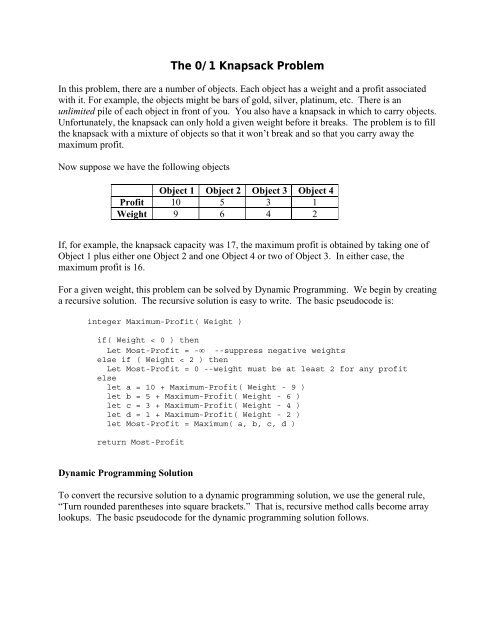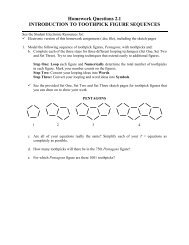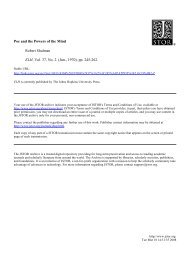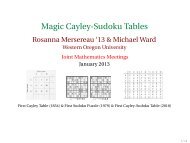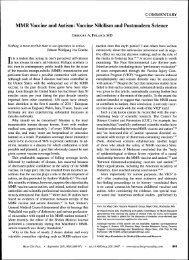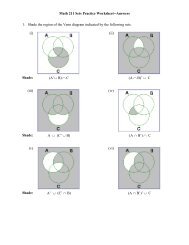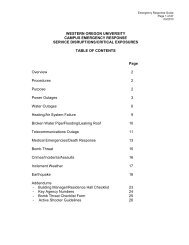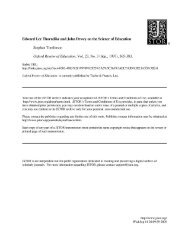The 0/1 Knapsack Problem
The 0/1 Knapsack Problem
The 0/1 Knapsack Problem
Create successful ePaper yourself
Turn your PDF publications into a flip-book with our unique Google optimized e-Paper software.
<strong>The</strong> 0/1 <strong>Knapsack</strong> <strong>Problem</strong>In this problem, there are a number of objects. Each object has a weight and a profit associatedwith it. For example, the objects might be bars of gold, silver, platinum, etc. <strong>The</strong>re is anunlimited pile of each object in front of you. You also have a knapsack in which to carry objects.Unfortunately, the knapsack can only hold a given weight before it breaks. <strong>The</strong> problem is to fillthe knapsack with a mixture of objects so that it won’t break and so that you carry away themaximum profit.Now suppose we have the following objectsObject 1 Object 2 Object 3 Object 4Profit 10 5 3 1Weight 9 6 4 2If, for example, the knapsack capacity was 17, the maximum profit is obtained by taking one ofObject 1 plus either one Object 2 and one Object 4 or two of Object 3. In either case, themaximum profit is 16.For a given weight, this problem can be solved by Dynamic Programming. We begin by creatinga recursive solution. <strong>The</strong> recursive solution is easy to write. <strong>The</strong> basic pseudocode is:integer Maximum-Profit( Weight )if( Weight < 0 ) thenLet Most-Profit = -∞ --suppress negative weightselse if ( Weight < 2 ) thenLet Most-Profit = 0 --weight must be at least 2 for any profitelselet a = 10 + Maximum-Profit( Weight - 9 )let b = 5 + Maximum-Profit( Weight - 6 )let c = 3 + Maximum-Profit( Weight - 4 )let d = 1 + Maximum-Profit( Weight - 2 )let Most-Profit = Maximum( a, b, c, d )return Most-ProfitDynamic Programming SolutionTo convert the recursive solution to a dynamic programming solution, we use the general rule,“Turn rounded parentheses into square brackets.” That is, recursive method calls become arraylookups. <strong>The</strong> basic pseudocode for the dynamic programming solution follows.
void Maximum-Profit( Weight )--Initialize two arrays, Profits[] and Weights[], of size 0 to Weight.--Initialize both arrays to zeros.--Declare 6 integer variables: a, b, c, d, p, and wfor currentWeight = 0 to Weight doLet a = 0if( currentWeight – 9 ≥ 0 ) thenLet a = 10 + Profits[ currentWeight – 9 ]Let b = 0if( currentWeight – 6 ≥ 0 ) thenLet b = 5 + Profits[ currentWeight – 6 ]Let c = 0if( currentWeight – 4 ≥ 0 ) thenLet c = 3 + Profits[ currentWeight – 4 ]Let d = 0if( currentWeight – 2 ≥ 0 ) thenLet d = 1 + Profits[ currentWeight – 2 ]Let p = Maximum( a, b, c, d )if( p = a ) thenLet w = 9else if ( p = b ) thenLet w = 6else if( p = c ) thenLet w = 4elseLet w = 2Let Profits[ currentWeight ] = pLet Weights[ currentWeight ] = w--To print a solutionPrint “Maximum Profit is ” + Profits[ Weight ]--To print the objects used to get the maximum profitLet i = Weightwhile( i > 0 ) doPrint “An object of weight ” + Weights[ i ] + “ was used.”Let i = i – Weights[ i ]Memoized SolutionFor a memoized solution, the two arrays Profits[] and Weights[] must be declared andinitialized in a scope that is larger than the method Maximum-Profit(). If you have anyexperience with Lisp and know what a helper function is, this is a good situation to use a helperfunction. <strong>The</strong> array Weights[] can be initialized to all zeros, but the array Profits[] must beinitialized to a unique value that represents “empty”. This unique value must be different than azero.
integer Maximum-Profit( Weight )if( Weight < 0 ) thenLet Most-Profit = -∞ --suppress negative weightselse if ( Weight < 2 ) thenLet Most-Profit = 0 --weight must be at least 2 for any profitelse--Declare 5 integer variables: a, b, c, d, and wif( Weight – 9 < 0 ) thenLet a = -∞ --suppress negative weightselseif( Profits[ Weight – 9 ] is empty ) thenLet Profits[ Weight – 9 ] = Maximum-Profit( Weight – 9 )Let a = 10 + Profits[ Weight – 9 ]if( Weight – 6 < 0 ) thenLet b = -∞ --suppress negative weightselseif( Profits[ Weight – 6 ] is empty ) thenLet Profits[ Weight – 6 ] = Maximum-Profit( Weight – 6 )Let b = 5 + Profits[ Weight – 6 ]if( Weight – 4 < 0 ) thenLet c = -∞ --suppress negative weightselseif( Profits[ Weight – 4 ] is empty ) thenLet Profits[ Weight – 4 ] = Maximum-Profit( Weight – 4 )Let c = 3 + Profits[ Weight – 4 ]if( Weight – 2 < 0 ) thenLet d = -∞ --suppress negative weightselseif( Profits[ Weight – 2 ] is empty ) thenLet Profits[ Weight – 2 ] = Maximum-Profit( Weight – 2 )Let d = 1 + Profits[ Weight – 2 ]Let Most-Profit = Maximum( a, b, c, d )if( Most-Profit = a ) thenLet w = 9else if ( Most-Profit = b ) thenLet w = 6else if( Most-Profit = c ) thenLet w = 4elseLet w = 2Let Weights[ Weight ] = wreturn Most-Profit


